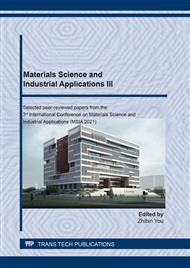[1]
R. Geyer, J.R. Jambeck, and K.L. Law, Production, use, and fate of all plastics ever made,, Science Advances, vol. 3 (1700782), pp.1-5, (2017).
DOI: 10.1126/sciadv.1700782
Google Scholar
[2]
J.R. Jambeck, R. Geyer, C. Wilcox, T.R. Siegler, M. Perryman, A. Andrady, R. Narayan, and K.L. Law, Plastic waste inputs from land into the ocean,, Science, vol. 347 (6223), pp.768-771, (2015).
DOI: 10.1126/science.1260352
Google Scholar
[3]
H. Dahlbo, V. Poliakova, V. Myllari, O. Sahimaa, and R. Anderson, Recycling potential of post-consumer plastic packaging waste in Finland,, Waste Management, vol. 71, pp.52-61, (2018).
DOI: 10.1016/j.wasman.2017.10.033
Google Scholar
[4]
J.M. Soto, G. Blazquez, M. Calero, L. Quesada, V. Godoy, and M.A. Martin-Lara, A real case study of mechanical recycling as an alternative for managing of polyethylene plastic film presented in mixed municipal solid waste,, Journal of Cleaner Production, vol. 203, pp.777-787, 2018. [5] P.G. Clem, M. Rodriguez, J.A. Voigt and C.S. Ashley, U.S. Patent 6,231,666. (2001).
DOI: 10.1016/j.jclepro.2018.08.302
Google Scholar
[5]
D.S. Gabriel, How to increase plastic waste acceptance for mechanical recycling: An introduction to material value conservation and its phenomenon,, Key Engineering Materials, vol. 705, pp.362-367, (2016).
DOI: 10.4028/www.scientific.net/kem.705.362
Google Scholar
[6]
M.K. Eriksen, and T.F. Astrup, Characterization of source separated, rigid plastic waste and evaluation of recycling initiatives: effects of product design and source-separation system,, Waste Management, vol. 87, pp.161-172, (2019).
DOI: 10.1016/j.wasman.2019.02.006
Google Scholar
[7]
D.S. Gabriel, and J. Maulana, Impact of plastic labelling, coloring and printing on material value conservation in the products of secondary recycling,, Key Engineering Materials, vol. 773, pp.384-389, (2018).
DOI: 10.4028/www.scientific.net/kem.773.384
Google Scholar
[8]
D.S. Gabriel, M. Habiburrahman, and P.J. Endthen, Material value conservation: Development of design criteria for rigid plastic packaging,, Material Science Forum, vol. 936, pp.110-115, (2018).
DOI: 10.4028/www.scientific.net/msf.936.110
Google Scholar
[9]
R. Nurcahyo, D.S. Gabriel, and W.L. Ikhsan, Repetitive implementation of material value conservation and its effects on the mechanical properties of plastic recycling products,, Material Science Forum, vol. 936, pp.116-120, (2018).
DOI: 10.4028/www.scientific.net/msf.936.116
Google Scholar
[10]
T.A. Oliveira, R.R. Oliveira, R. Barbosa, and J.B. Azevedo, Effect of reprocessing cycles on the degradation of PP/PBAT-thermoplastic starch blends,, Carbohydrate Polymers, vol. 168, pp.52-60, (2017).
DOI: 10.1016/j.carbpol.2017.03.054
Google Scholar
[11]
Y. Zheng, F. Gu, Y. Ren, P. Hall, and N.J. Miles, Improving mechanical properties of recycled polypropylene-based composite using Taguchi and ANOVA techniques,, Procedia CIRP, vol. 61, pp.287-292, (2017).
DOI: 10.1016/j.procir.2016.11.137
Google Scholar
[12]
C. Sanchez, M. Hortal, C. Aliaga, A. Devis, and V.A. Cloquell Ballester, Recyclability assessment of nano-reinforced plastic packaging,, Waste Management, vol. 34, pp.2647-2655, (2014).
DOI: 10.1016/j.wasman.2014.08.006
Google Scholar
[13]
F.W. Billmeyer, Textbook of polymer science, 3rd ed., New York: John Wiley & Sons, (1984).
Google Scholar
[14]
J. Botos, N. Murail, P. Heidemeyer, K. Kretschmer, B. Ulmer, T. Zentgraf, M. Bastian, and T. Hochrein, Color measurement of plastics – from compounding via pelletizing, up to injection molding and extrusion,, AIP Conference Proceedings, vol. 1593, pp.16-19, (2014).
DOI: 10.1063/1.4873725
Google Scholar
[15]
J.A. Brydson, Plastics materials, 4th ed., London: Butterworth Scientific, (1982).
Google Scholar
[16]
V. Shah, "Handbook of plastics testing and failure analysis, 3rd ed., New York: John Wiley & Sons, (2007).
Google Scholar
[17]
W.S. Mokrzycki, and M. Tatol, Colour difference Delta E – A survey,, Machine Graphics and Vision, vol. 20, pp.383-412, (2011).
Google Scholar
[18]
D.S. Gabriel, B.A.J. Pratama, and C. Hapsari, Plastic packaging material value conservation and the structure of stakeholder role,, Key Engineering Materials, vol. 773, pp.396-404, (2018).
DOI: 10.4028/www.scientific.net/kem.773.396
Google Scholar
[19]
D.S. Gabriel, D. Isnandar, and A. Jeremia, Plastic packaging material value conservation and evident of the consumers acceptance,, Key Engineering Materials, vol. 773, pp.390-395, (2018).
DOI: 10.4028/www.scientific.net/kem.773.390
Google Scholar
[20]
D.S. Gabriel, and A.W. Anindityo, Development of stakeholder roles in supporting material value conservation of plastic packaging using brain-writing and interpretative process,, International Journal of Technology, vol. 7, pp.1361-1370, (2017).
DOI: 10.14716/ijtech.v8i7.722
Google Scholar


